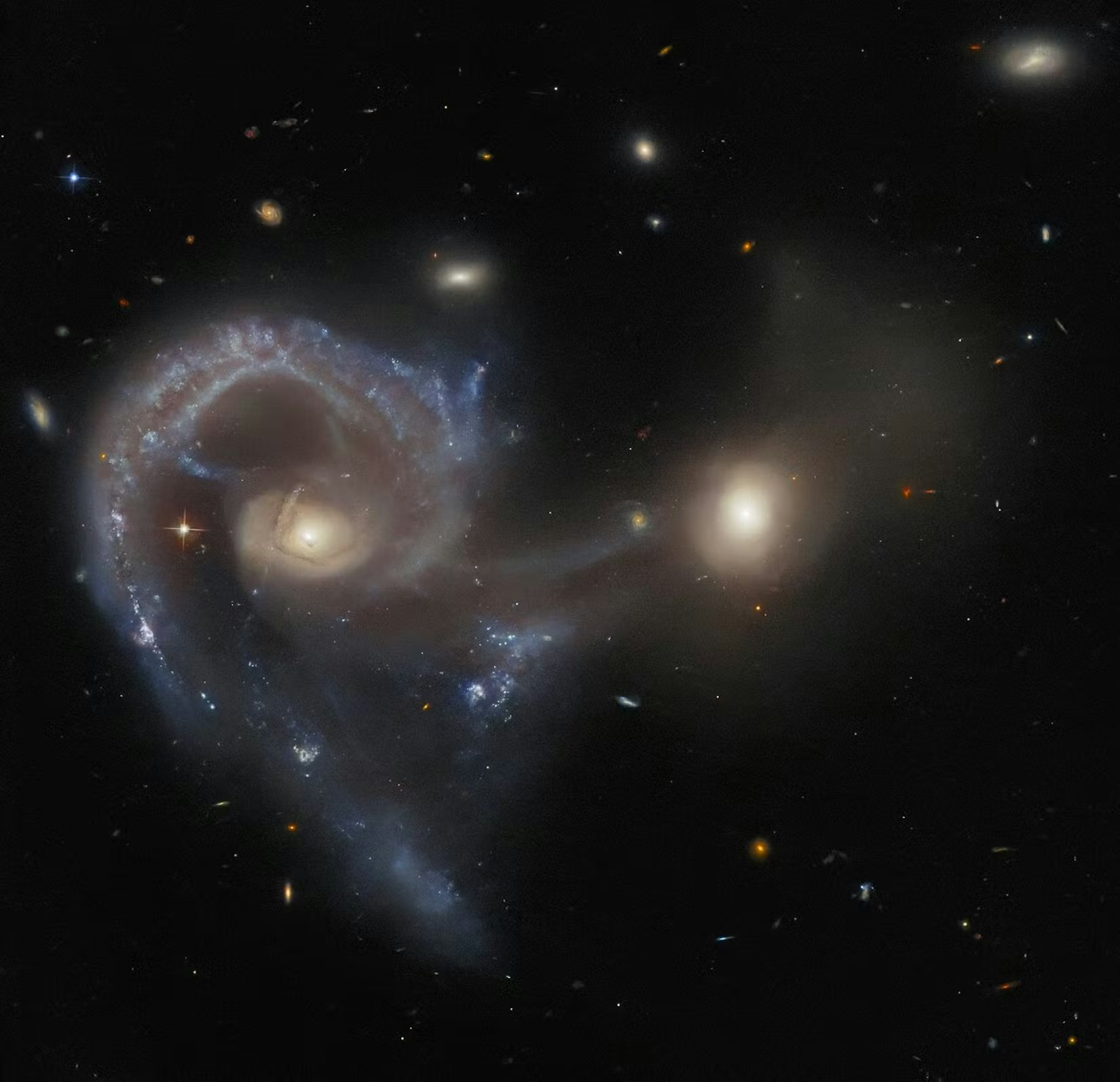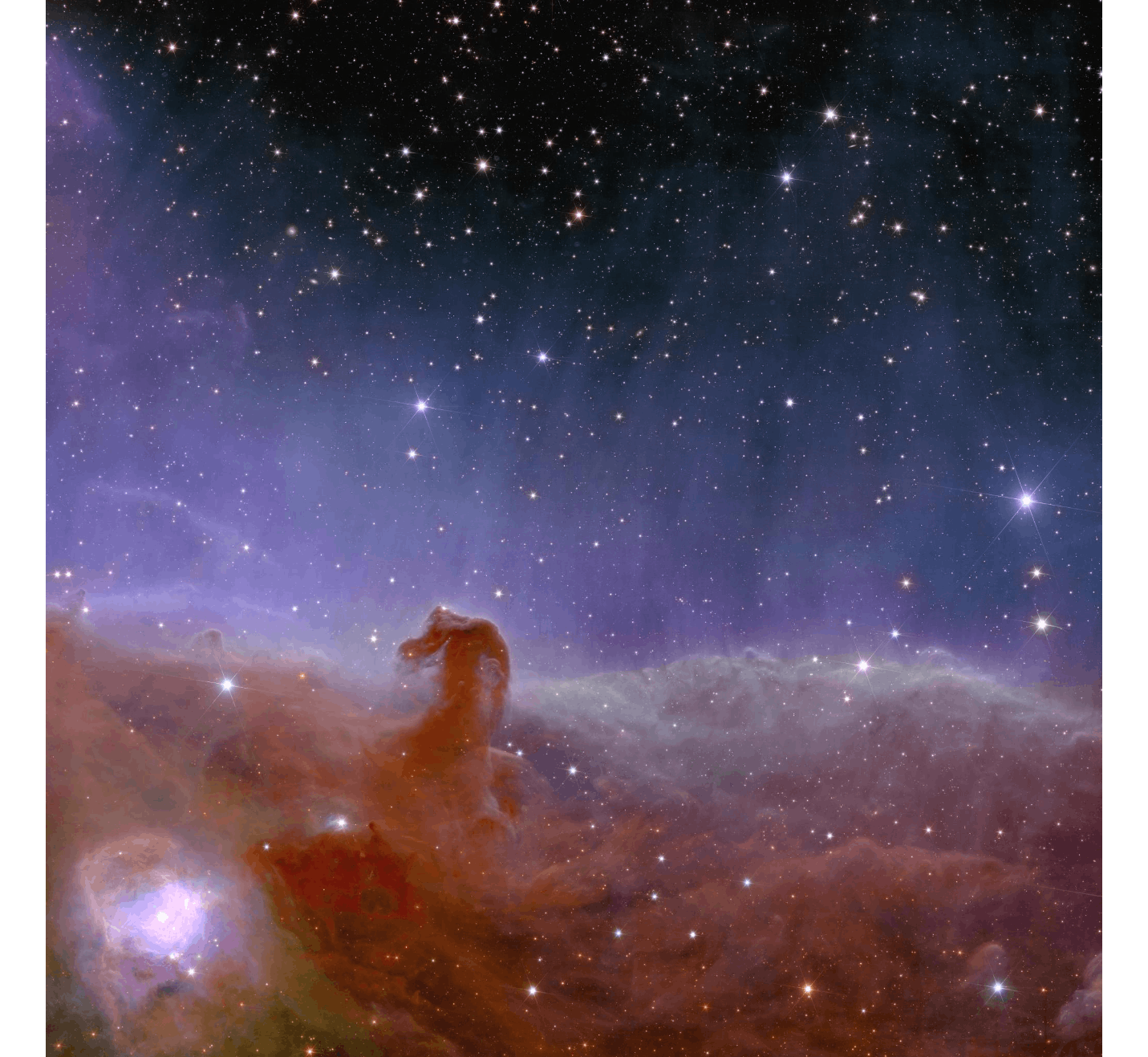
It was a prime year for gazers of the greater Cosmos. NASA’s James Webb Space Telescope (JWST) saw its first full year of operation in 2023, and the venerable Hubble Space Telescope is still trucking, 33 years strong. NASA’s sungrazing Parker Solar Probe peered at our home star while massive ground-based telescopes mapped distant galaxies. The European Space Agency finally got its dark universe-studying Euclid space telescope into deep space.
Given all that astronomical hardware, it would be more of a surprise if 2023 did not yield a bevy of stunning and sublime images of the Solar System and beyond. Here are our picks for the 12 best space images of the year:
12. The dancing Arp 107 Pair

In 1966, astronomer Halton Arp published the Arp Atlas, a catalog of 338 weird and wonky galaxies throughout the universe. The 107th entry — Arp 107 — is a pair of galaxies about 450 million light-years away and locked in a long-term gravitational dance that will eventually lead to their merging as one. But in the meantime, immense tidal forces have distorted the larger galaxy such that it seemingly trails one lopsided spiral arm through space; like a dancer’s extended leg, only made of dust, gas, and stars.
11. The Taffy Galaxies

About 25 million years ago, UGC 12914 and UGC 12915 crashed into each other with cataclysmic violence: Rather than begin a gravitational dance leading to an eventual merger as with the Arp 107 pair, these two galaxies plowed through one another, leaving a stretchy bridge of hot, roiling gas strung out between them. Astronomers captured this image with the ground-based Gemini North Telescope on Mauna Kea in Hawaii, showing the taffy-like bridge of gas in a bright scarlet hue. Though filled with star stuff, the bridge is devoid of newborn suns — the material is still too turbulent even millions of years after the collision.
10. The Spare Tire Nebula

In an image captured by the Gemini South Telescope in Chile, the Spare Tire Nebula looks less automotive than mystical, a glowing, seemingly undulating pink and blue orb quivering in the dark 3,000 light-years away. The Spare Tire Nebular is a planetary nebula, the result of the death throes of a star about the same mass as our Sun. After exhausting its nuclear fuel, it shed its outer layers of hot gas, leaving a white dwarf — a slowing, cooling ghost of a star. Those pretty pinks and blues are hot gas exploding into space at more than 112,000 miles per hour.
9. Caterpillar Cloudscape

One of the first images taken by JWST in 2022 was the stunning Cosmic Cliffs, a glittering cosmic cloudscape that’s just one part of the immense Carina Nebula, a vast cloud of stellar gas more than 40 light-years across. But this year, JWST zoomed in on a region of the Carina Nebula that’s more cute than it is impressively massive. The so-called Bok globule is a cloud of mostly gas and dust that resembles a tiny caterpillar, even though it’s still two light-years long. The dense gas and dust of Blok globules render them opaque in visible and ultraviolet wavelengths of light, but the infrared instruments of the JWST can probe within. Astronomers believe it will eventually collapse in on itself to create new star systems.
8. The Ring Nebula

A giant eye with a blue-green pupil and purplish iris? A portal to some sunny alien archipelago? This stunning JWST image of the Ring Nebula, located about 2,300 light-years away in the constellation Lyra, invites all kinds of artistic projection. In reality, it’s a planetary nebula like the Spare Tire Nebula. But in this case, the dying star has an orbital companion star, and their gravitational interaction strews the last remnants of the dying star’s gas shell out into space to form the colorful patterns so pleasing to the human eye. The Ring Nebula was one of the first objects imaged by JWST in 2022, but this new observation peers deeper into the nebula’s structure using JWST’s near and mid-infrared instruments, NIRCam and MIRI, which can see through dust and gas that would occlude the view for optical wavelength telescopes.
7. Orion Bar

The Orion Nebula lies about 1,350 light-years away and appears to Earthlings as the middle “star” in the sword of the constellation Orion. A diffuse nebula, this vast cloud of gas is a giant star nursery, feeding young suns and, potentially, providing the material from which their planets may form. A new JWST image of a section of the nebula known as the Orion Bar illustrates how nebula gas and the power of fledgling stars may interact to produce the materials for life. The ultraviolet radiation of the young stars powers chemical changes in the gasses of the bar, and JWST detected, for the first time, a signal for methyl cation (CH3+), a compound theorized to spur the creation of more complex carbon-based molecules.
6. Horsehead Nebula

The European Space Agency designed its Euclid telescope, launched into space in July, to survey wide swaths of the sky and measure the shapes of galaxies — a strategy to indirectly measure the influence of enigmatic dark matter and dark energy on the Cosmos. But some of the first images released from the Euclid team include stunning images of singular celestial displays, like this new image of the Horsehead Nebula. Like the Orion Bar, the Horsehead Nebula lies in the constellation Orion, but in Orion’s “belt,” about 1,375 light-years away. Another stellar nursery, still forming young stars in the process of forming, can be seen within the horse’s head.
5. Green Comet and the Dippers

On Feb. 1, the “green comet” C/2022 E3 (ZTF) passed within 26 million miles of Earth, the comet’s closest approach in around 50,000 years. Astronomer Petr Horalek of the Institute of Physics in Opava, Czech Republic, photographed the comet in January while it was still on its way toward its closest approach to Earth, framing the greenish, almost turquoise cometary tail between the two of the most well-known constellations, the Big and Little Dippers. The green hue is due to large amounts of carbon in the comet, released as the comet warmed while approaching the Sun, and stretched out into a tail by the efflux of charged particles emitted by the Sun, the solar wind.
4. Perseid Meteor Shower

Speaking of comets' tails, these seemingly ephemeral displays don’t simply evaporate once a comet passes on its way out of the Solar System. The trails of debris, tiny particles of dust, persist long after the comet is gone. And the Earth can’t just swerve to avoid them — that’s what gives rise to annual meteor showers like the Perseids. Every August, the Earth passes through the trail left by Comet 109P/Swift-Tuttle during its 133-year orbit of the Sun, and tiny pieces of the comet streak across the skies as shooting stars. The 2023 Perseid shower was a treat for skywatchers. A New Moon meant no lunar light to drown out the Perseid shower, and we loved these images of these tiny comet fragments self-immolating against a backdrop of stars.
3. Bubblegum Jupiter

While big space telescopes like Hubble are maybe best known for taking images of impossibly distant celestial objects, scientists do sometimes train those big eyes in the sky on the planets of our own Solar System. That’s exactly what led to this new Hubble image of Jupiter published by NASA in November. Instead of the bands of orange and white clouds decked with swirling red storms seen in visible light images of Jupiter, this ultraviolet image of our Solar System’s largest planet reveals clouds of pink, purple, and blue, with the famous Giant Red spot showing up as a deep cerulean. It’s the bubblegum pop version of the immense gas giant, but that doesn’t mean it’s light on science — astronomers can use ultraviolet images to see how different compounds glow in sunlight and to map the three-dimensional structure of water clouds in Jupiter’s vast atmosphere.
2. Solar Blast Clears Away Dust

Our penultimate best space image of 2023 is actually a video, a video taken from one of the most hostile places in the Solar System. NASA built its Parker Solar Probe to study high-energy solar physics by flying a highly elliptical orbit that sees it fly within 5 million miles of the Sun’s surface. It’s a flight path that takes the probe through the outermost layer of the Sun’s atmosphere, the superheated solar corona, where it endures temperatures of up to 2,500 degrees Fahrenheit. On Sept. 5, the Parker Probe was able to catch a never-before-seen event — the effects of a coronal mass ejection, or CME, on interplanetary space. CMEs are eruptions of massive magnetic fields and superheated plasma that tear free from the Sun’s corona and shoot out into space, and this video shows a CME blasting away the fine medium of interplanetary dust that suffuses the Solar System. The void left behind is quickly refilled by more dust.
These kinds of observations will help solar physicists better understand CMEs, which can directly impact Earth — when the magnetic fields and charged particles from a CME strike the Earth’s magnetic field, they generate geomagnetic storms that can interfere with electronics and radio signals, and even cause the atmosphere to expand. In February 2022, a CME and resulting geomagnetic storm caused the atmosphere to swell enough that it dragged 40 newly launched SpaceX Starlink satellites out of their orbits.
1. “Ring of Fire” Solar Eclipse

Our top space image for 2023 was a ring of fire in the sky. On Oct. 12, photographers turned their cameras skyward to capture an annular solar eclipse over North America. Solar eclipses occur when the Moon passes between the Earth and the Sun, casting a shadow on the ground. Depending on the Moon’s distance from the Earth at the time of the eclipse, the Moon can completely occlude the disk of the Sun, creating a total solar eclipse, or it may leave just a thin edge of the Sun visible around the edges, resulting in the stunning ring of fire of an annular eclipse for those in the Moon shadow’s path. In October, the Moon’s shadow swept over the U.S., beginning in Oregon and followed an 8,574-mile path southeast that ended in Eastern Brazil and the Atlantic Ocean. If you missed the October eclipse, you can peruse these images taken by photographers, or make plans for April 8, 2024. That’s when the next total solar eclipse will pass over the U.S., sweeping from southern Texas to the Northeast, eventually passing over New England and northeast Canada.
*Doris Elín Urrutia contributed additional reporting, including image selection, for this story.







